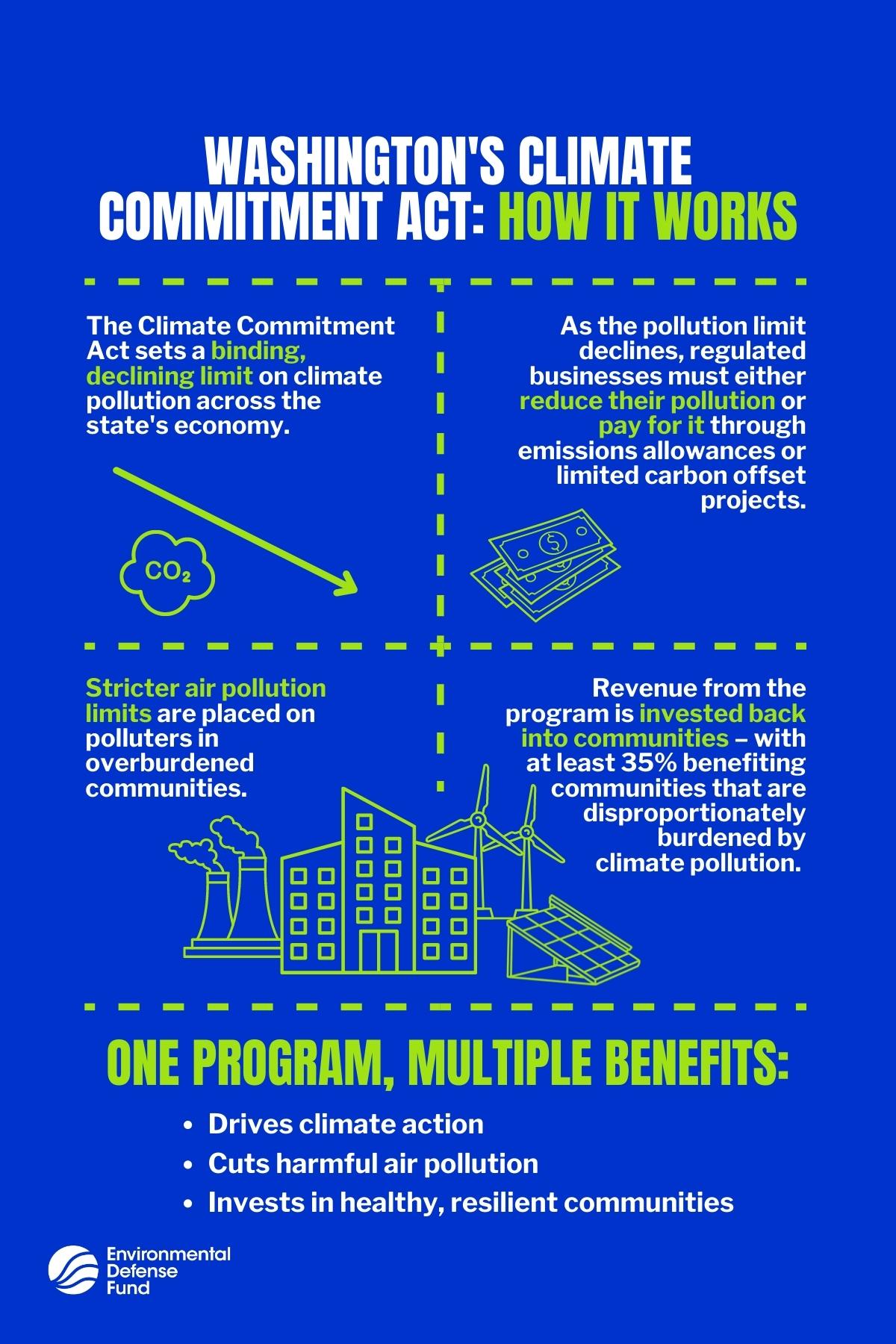Blog co-authored by Kjellen Belcher, Manager, U.S. Climate
Washington state is getting ready for an exciting development in its new nation-leading climate program, the Climate Commitment Act, which is slated to deliver healthier air, more clean energy jobs and a safer climate future for communities.
After experiencing costly and historic wildfires, heat waves and flooding — all within the past few years — Washington communities are ready for this cap-and-invest program to fast-track the transition to a stronger and more equitable, clean economy. Now, the program will take a major step forward with Washington’s first allowance auction to be held on February 28.
Here’s what you should know about the program and how the allowance auction works.
Refresher on the Climate Commitment Act
The Climate Commitment Act made Washington the second state to put a binding pollution limit across all major sectors of its economy — a powerful and essential tool to aggressively slash emissions to meet the state’s 2030, 2040 and 2050 goals. Alongside reductions in global climate pollution, the program includes innovative measures designed to reduce local air pollution in communities that are disproportionately burdened by environmental and health impacts.
This dual focus on curbing global climate pollution and local air pollution makes Washington’s program the gold standard for climate policy.
Furthermore, the program improves livelihoods by investing the revenue raised from the program into communities to build climate resilience, improve air quality and create jobs. At least 35%, with a goal of 40%, of these investments will provide direct and meaningful benefits to communities that are disproportionately burdened with environmental harms and health impacts. An additional 10% will fund projects supported by Tribal communities.
What to expect when you’re… having an allowance auction
As Washington makes its allowance auction debut at the end of next month, many will be watching to see the number of allowances purchased and what kind of price signals emerge from the auction results.
In late February, Washington’s Department of Ecology (Ecology) will hold its first of four quarterly allowance auctions for the year. During the quarterly auctions, regulated businesses with greenhouse gas emissions subject to the Climate Commitment Act’s declining pollution cap have an opportunity to purchase emissions allowances, which are permits to emit one metric ton of greenhouse gas emissions. Each regulated business is required to hold one allowance for every ton of greenhouse gases that it emits, and critically, each year Ecology will create only as many allowances as the “cap,” or pollution limit, allows. The cap is lowered annually, shrinking the number of pollution allowances available over time and, therefore, the level of allowable greenhouse gas pollution from sources subject to the program.
As the cap gets lower and lower, these businesses must either:
- Purchase emissions allowances from Ecology at the auction, with the total allowances available limited by the cap and declining over time,
- Directly reduce their own pollution, or
- To satisfy a small percentage of their compliance obligation, they can obtain offset credits from projects that help to store or sequester carbon pollution from the atmosphere, such as reforestation projects. Offset credits can only be used to cover a maximum 5-8% of a regulated entity’s emissions.
The cost of purchasing an allowance at auction is set by the market, based on the bids submitted by auction participants. This allowance price creates an important signal for emitters, imposing a cost for continued emissions and providing an additional incentive to cut climate pollution swiftly.
Features that ensure stable, predictable prices
When designing the program, Ecology also included key features and mechanisms for the auction to ensure stable and predictable prices: the price floor, price ceiling and the allowance price containment reserve (APCR).
- The price floor works as a minimum price for allowances. Allowance prices cannot drop below the price floor, which ensures that regulated entities are still subject to a minimum price signal to reduce emissions even in a scenario where demand for allowances becomes relatively low. The price floor also maintains a certain and reliable minimum level of revenue from the auctions, which is invested in projects that will further reduce greenhouse gas emissions and improve air quality.
- The price ceiling tackles the other side of the equation, ensuring that the cost of allowances does not rise above a maximum price set by Ecology. Importantly, any revenue from the sale of allowances at the price ceiling will be used to purchase further emissions reductions on a ton-for-ton basis, preserving the integrity of the cap.
- Finally, the Allowance Price Containment Reserve (APCR) in Washington operates as a soft price ceiling, providing an additional layer of stability to the market’s price signal. A certain volume of allowances – 5% of the annual cap per year – are held in a reserve and are not available at auction unless specific trigger prices are reached. If prices go above a certain level (for 2023, the Tier 1 price in Washington is $46.05 per allowance), then the reserve allowances become available in the market, which helps to contain costs for covered entities. It’s important to note that all of the allowances in the APCR come from under the cap, meaning they are part of the program’s allowance budget and are not additional to the emissions allowed by the program’s declining cap.
All of these features of Washington’s program work to reduce price volatility in the auctions, which is essential to the durability of the program. Being able to anticipate market behavior makes it easier for regulated participants to plan their emission reduction efforts based on a predictable cost for their emissions, making the program more likely to succeed in the long run. Washington’s price floor, price ceiling, and APCR trigger prices are set at the same level as in California’s cap-and-trade program, building alignment between the two markets.
The rollout of Washington’s groundbreaking program is a huge win for climate progress and comes at a major moment of opportunity for states to supercharge their climate action with an estimated $369 billion in federal investments in clean energy, clean transportation, industrial decarbonization, and environmental justice that were included in the Inflation Reduction Act (IRA). These investments make clean technology solutions cheaper than ever before, working alongside Washington’s cap-and-invest program to drive historic investment, pollution reduction, and clean job creation.
Learn more about Washington’s cap-and-invest auctions in our FAQ here.
Stay tuned here for EDF blog updates on Washington’s Climate Commitment Act and analyses of auction results.











